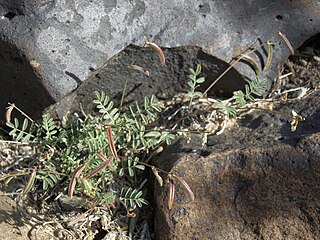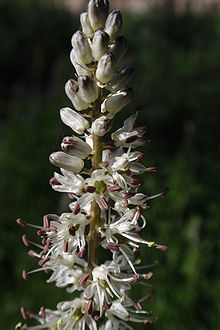
Asphodelus fistulosus is a species of plant known as hollow-stemmed asphodel, onionweed, onion-leafed asphodel, and pink asphodel. It is native to the Mediterranean region. It is an invasive exotic weed in the United States, with significant infestations in California, Arizona, New Mexico, and Texas. It is listed as a Federal Noxious Weed by the United States Department of Agriculture. It is also a common weed in parts of Australia, New Zealand, and Mexico, and it thrives in any area with a Mediterranean climate.

Thunbergia alata, commonly called black-eyed Susan vine, is a herbaceous perennial climbing plant species in the family Acanthaceae. It is native to Eastern Africa, and has been naturalized in other parts of the world.

Platystemon is a monotypic genus of flowering plants in the poppy family containing the single species Platystemon californicus, which is known by the common name creamcups. It is native to Oregon, California, Arizona, Utah and Baja California, and is found in open grasslands and sandy soils below 6,000 feet (1,800 m) elevation.

Allium campanulatum is a species of wild onion known by the common name dusky onion or Sierra onion. This is a flowering plant native to the western United States from southeastern Washington and northern Oregon to southern California, and western Nevada. The dusky onion grows in foothills and mountains, especially in dry areas, such as chaparral habitats.

Rhynchospora alba, the white beak-sedge, is a plant in the sedge family, Cyperaceae. It is a tufted herbaceous perennial around 50 cm tall, with white inflorescences that flower in August. The fruit of the sedge is a small achene with a characteristic beak-like cap. It is dispersed by wind or falls by gravity, leading to individuals existing in tight clumps. The species favours wet, acidic and nutrient poor soils, thriving in Sphagnum-dominated bogs, but also peaty grasslands. As such, it is often used as a positive indicator for bog and mire ecosystem health.

Triteleia lilacina, the foothill triteleia, is a monocot flowering plant in the genus Triteleia.

Hastingsia serpentinicola is a species of flowering plant known by the common name Klamath rushlily. It is native to the mountains of northwestern California and southwestern Oregon, where it grows in serpentine soils.

Allium tuolumnense is a rare species of wild onion, known by the common name Rawhide Hill onion.

Astragalus acutirostris is a species of milkvetch known by the common name sharpkeel milkvetch. It is native to the Mojave Desert and surroundings of California, Nevada, and Arizona, where it grows in dry, sandy, gravelly areas.

Freesia alba is a species of flowering plant in the iris family. Some sources consider it to be a subspecies of Freesia leichtlinii, F. leichtlinii subsp. alba. It is native to the Cape Provinces of South Africa, but this species and hybrids are known on other continents where they have been introduced. Freesia alba is an herbaceous perennial growing from a corm and producing an erect, often branched stem up to 40 cm (16 in) centimeters tall with several leaves up to about 15 centimeters long. The inflorescence is a spike of several fragrant flowers with usually white tepals marked with yellow and purple.

Scirpus cyperinus, commonly known as woolgrass, is an emergent wetland herb that is native to the eastern United States and eastern Canada. Other common names include cottongrass bulrush and brown woolly sedge.

Odontostomum is a monotypic genus of flowering plants containing the single species Odontostomum hartwegii, which is known by the common name Hartweg's doll's-lily. In the APG III classification system, it is placed in the family Tecophilaeaceae. It was formerly placed in the Liliaceae. It This wildflower is endemic to northern California, where it can be found in the inner coastal mountain ranges and the Sierra Nevada foothills. It grows in rocky clay and often serpentine soils in grassland and woodland habitat, sometimes near vernal pools. This is a perennial herb growing from an oval-shaped corm up to 3 centimeters wide deep in the soil. The curving, widely branching stem is up to about half a meter in maximum height with linear leaves up to 30 centimeters long sheathing the lower portion. The inflorescence is a raceme or panicle of several flowers on pedicels. Each flower has six white or yellowish tepals, the lower parts fused into a veined tube and the tips spreading and then becoming reflexed. At the center of the flower are six stamens and six staminodes in a ring around the gynoecium.

Reseda alba is a species of flowering plant in the reseda family known by the common names white mignonette or white upright mignonette. It is native to Europe, Asia, and North Africa, and it can be found in parts of the Americas and Australia as an introduced species. It is also cultivated as an ornamental plant for its spikelike racemes of fragrant white flowers. This is an annual or perennial herb growing up to a meter tall. The leaves are divided deeply into many narrow lobes. The inflorescence, which may take up most of the upper stem, is densely packed with many white flowers. Each flower has five or six petals, each of which is divided into three long, narrow lobes, making the raceme appear frilly. The fruit is a nearly rectangular four-angled capsule up to 1.4 centimeters in length.

Triteleia hyacinthina is a species of flowering plant known by the common names white brodiaea, white tripletlily, hyacinth brodiaea, and fool's onion. It is native to western North America from British Columbia to Idaho to central California. Its habitat includes grassland and vernally moist areas such as meadows and vernal pools. It is a perennial herb growing from a corm. It produces two or three basal leaves up to 40 centimeters (16 in) long by 2 centimeters (0.79 in) wide. The inflorescence arises on an erect stem up to 60 centimeters (24 in) tall and bears an umbel-like cluster of many flowers. Each flower is a funnel-shaped bloom borne on a pedicel up to 5 centimeters (2.0 in) long. The flower is white, often tinged purple along the tubular throat, with six green-veined tepals. There are six stamens with white, yellow, or occasionally blue anthers.

Triteleia montana is a monocot flowering plant in the genus Triteleia. Its common names include Sierra triteleia, and mountain triteleia. It is endemic to California, where it is limited to the Sierra Nevada. It occurs in coniferous forests on granite soils. The Latin specific epithet montana refers to mountains or coming from mountains. It is a perennial wildflower growing from a corm. There are two or three basal leaves measuring up to 30 centimeters long and just a few millimeters wide. The inflorescence arises on an erect, rough-haired stem up to 25 or 30 centimeters tall. It is an umbel-like cluster of several flowers each borne on a pedicel up to 3 centimeters long. The flower is yellow with a dark midvein, and dries purplish. The funnel-shaped corolla is made up of six tepals up to a centimeter long each. There are six stamens with white or blue anthers.

Toxicoscordion paniculatum is a species of flowering plant known by the common names foothill deathcamas, panicled death-camas, and sand-corn. It is widely distributed across much of the western United States, especially in the mountains and deserts of the Great Basin region west of the Rocky Mountains. It grows in many types of habitat, including sagebrush plateau, grasslands, forests, and woodlands, etc.

Macbridea alba is a rare species of flowering plant in the mint family known by the common name white birds-in-a-nest. It is endemic to Florida in the United States, where it is found in four counties in the Florida Panhandle. It is threatened by the loss and degradation of its habitat, and it is federally listed as a threatened species of the United States.

Schoenocrambe argillacea is a rare species of flowering plant in the mustard family known by the common names clay reed-mustard, Uinta Basin plainsmustard, and clay thelypody.
Hastingsia bracteosa is a rare species of flowering plant in the agave subfamily of the asparagus family known by the common name large-flowered rushlily. It is endemic to Oregon in the United States, where it is limited to a twelve-mile stretch of the Illinois Valley in the southwestern part of the state.
Carex oronensis is a species of sedge known by the common name Orono sedge. It is endemic to Maine in the United States, where it occurs mainly in the Penobscot River Valley. It is the only plant that is endemic to the state of Maine. The type locality is Orono.


















